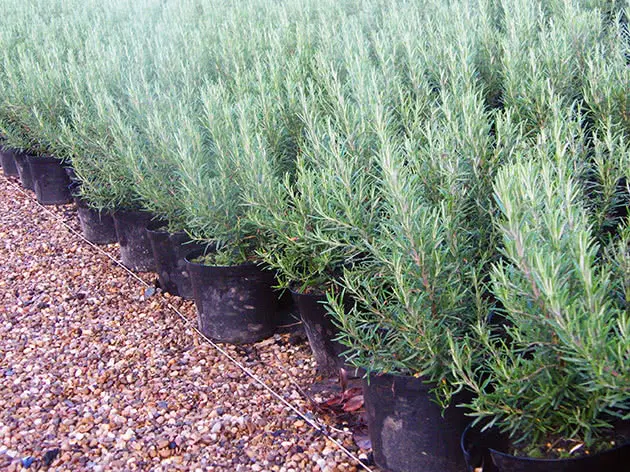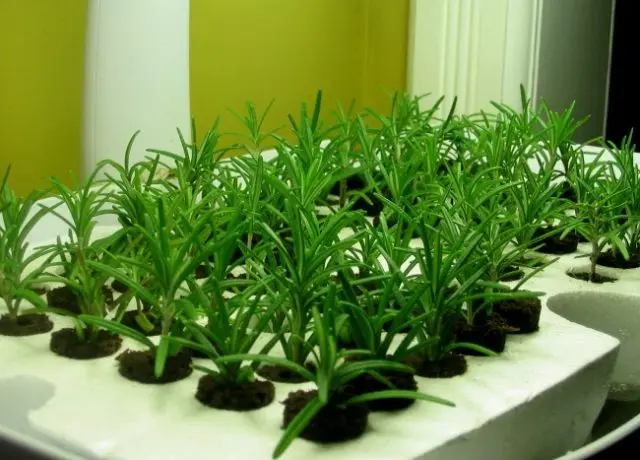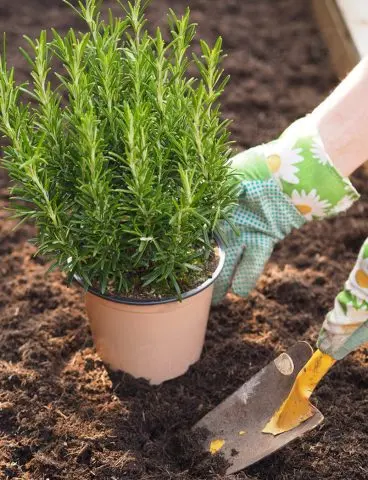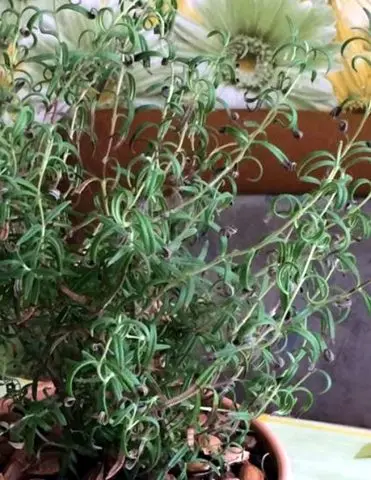Contents
Growing rosemary in open ground in the Moscow region is possible only in the summer. A spicy evergreen native to the Mediterranean, where it grows in a warm and humid climate. In regions with frosty winters, it is possible to grow an annual or perennial crop, but with the transfer of bushes in cold weather, indoors.
Where can you grow rosemary
The root system of a heat-loving plant dies already at a temperature of -5 … -7 ° С. Therefore, wintering of rosemary in the open field in the Moscow region and the Leningrad region is impossible.
In Krasnodar, when growing rosemary in open ground, you need to protect fragrant leaves from exposure to bright sunlight. Growing crops in this region is most favorable in greenhouses.

The evergreen shrub does not tolerate sudden changes in temperature, so in order to grow rosemary in the Urals and Siberia, you need to build temporary shelters for it. For the convenience of transferring plants indoors, in the cold season or in case of sudden frosts, it is best to grow rosemary in Siberia in planting containers.
Recommended landing dates
In open ground, the culture is planted by direct sowing, cuttings or seedlings. Growing in any way involves warming up the soil and establishing positive daytime and night air temperatures. In Krasnodar, they start growing spices from the end of April. In the Moscow region and the Leningrad region, the threat of return frosts disappears from mid-late May. In Siberia and the Urals, rosemary begins to grow from the beginning of June.
Planting rosemary in open ground in the fall is not carried out. At this time, cuttings are rooted, which are then kept in cool rooms until spring planting.
How to plant rosemary
Planting rosemary for seedlings begins in late February – early March. The seeds of the plant are small, dark and light brown in color. They are distinguished by low germination – about 15%, as well as a long germination period – 6-8 weeks after sowing. In some cases, it is necessary to grow seeds up to 3 months after sowing.
Choosing the right place
It is best to grow rosemary in a high, sunny place. In areas with good lighting, the culture shows its best qualities, acquires an intense color and aroma. It is impossible to grow spice in the lowlands, where moisture remains for a long time after precipitation or groundwater is located close to it. Under such conditions, its root system quickly rots and the bushes die.
During the hottest sunny days, there should be the possibility of shading the plant. Foliage easily gets sunburned. Growing outdoors on overheated soils, as well as a sharp change in day and night temperatures, is not useful for rosemary.
Soil preparation for rosemary
It is necessary to grow rosemary on light, loose soils. As well as soils with good permeability of moisture and air. Sandy and gravel areas, slopes are also suitable. To loosen heavy soils, vermiculite and sand are added to garden soil. Lime is added to acidic soils.
How to plant rosemary seedlings
Seeds of the crop can be grown dry or pre-soaked. To accelerate germination, they are kept in a damp cloth for 1-2 days. Being in water, mucus is formed around the seeds, which is their botanical feature.
To increase the percentage of germination, the seeds are soaked in hot water for 4 hours or sown in soil spilled with boiling water. They also use various root growth accelerators.

For planting, drainage layers are poured into the container: expanded clay, then river, fine sand. Components must be disinfected before being placed in a container by pouring hot water over them. For sowing, take light, fertile soil: a universal substrate or a mixture of sand and peat in a ratio of 1: 2. The soil before planting the seeds is thoroughly mixed and moistened.
Landing Features:
- You can grow seeds in individual cells or in a common planting capacity.
- Seeds are planted, scattering over the common surface of the soil or in rows.
- Pre-soaked seeds are more convenient to lay out in the soil with tweezers.
- The seeds are laid out without deepening more than 3-4 mm, then covered with a small layer of soil.
- Plantings are sprayed from a fine sprayer so as not to wash off small seeds from the soil surface.
- Planting containers are covered with a film in which several holes are made for the passage of air.
- Covered containers are placed in a lighted, warm place.
- It is necessary to grow seeds at a temperature of + 28 ° C.
- In anticipation of the appearance of sprouts, the film is periodically opened for ventilation, the soil is sprayed.
After the appearance of the first sprouts, the shelter is removed. You can grow rosemary in a common container until 3-4 true leaves appear, and then transplant into separate ones. Growing rosemary is more favorable in clay pots due to their good air permeability. The root system of the spice grows rapidly, so planting containers should not be less than 10 cm in diameter. But it should not be grown in disproportionately large pots either.
Growing seedlings in a room requires constantly turning the pots on different sides to the light, so that the foliage of the stems is formed evenly. During strong spring sunshine, seedlings must be grown with shade so that the plant does not get burned.
How to plant rosemary outdoors
Before you take the seedlings out of room conditions in open ground, it should be hardened. Hardening will help the plant to grow safely in conditions of more air and sun. To do this, the landing boxes are taken out into the street, exposing them to a warm and calm place. Every day, the duration of stay in the open air is increased by several hours.
Growing and caring for rosemary outdoors or planting it in a greenhouse depends on the weather conditions of the current season. A heat-loving plant can only be grown at positive temperatures.

It is necessary to grow a bush in open ground, taking into account its growth, leaving a space of about 50 cm on each side. For transplantation, holes are prepared with a volume slightly larger than the earthen clod in which the plant was grown before. Transplanted by transshipment. In order to less injure the root system, the earth lump is well moistened beforehand.
For planting the cuttings, a small narrow hole is made, lowering the planting material at a slight angle by 5-7 cm down. To plant a cutting, several lower leaves are cut off from him. After transplanting seedlings and cuttings, the soil around them is lightly pressed so that air voids do not form, and the plants take root faster. Cuttings take root after 1 month.
Rosemary flowering can be seen from the second year of the life of the bush, subject to a cool wintering. During flowering, the spice has the highest percentage of nutrients.
How to grow rosemary in a greenhouse or outdoors
Agrotechnics for growing rosemary is simple and consists in systematic moderate watering, loosening and sufficient lighting of the crop. Proper cultivation of the spice contributes to the formation of a densely leafy crown with bright green leaves. And rosemary reacts to violations in the care by throwing off the leaves, changing their color.
Watering Schedule
Both the drying of the soil and its waterlogging are unfavorable for growing rosemary. In the summer, the bushes should be watered once every few days. Each time, you should wait for the topsoil to dry by 1-2 cm. Do not use cold water for irrigation. Bushes are additionally moistened by spraying the leaves.
Rosemary nutrition
On highly fertile soils, rosemary can be grown without fertilizing. In other cases, mineral fertilizers are applied once a month.
The ratio of components for top dressing:
- 10 g of ammonium nitrate;
- 10 g of potassium sulfate;
- 15 g superphosphate;
- 5 L of water.
Nitrogen-containing fertilizers are applied to the root zone in spring, phosphorus-containing fertilizers in autumn. For top dressing, a mullein solution is also used in a ratio of 1: 5.
Weeding and loosening the soil
The place where rosemary is grown in the country should be free from weeds. Loosening the soil under the plant and between the rows contributes to better air circulation. It is especially important to loosen the soil after watering and rainfall in order to destroy the crust formed on its surface.
Trimming Rosemary
Pruning is carried out for bushes older than 2 years. Pruning shoots provokes the emergence of new shoots, allows you to form a crown in various ways. Bare stems are also removed, from which greens were removed during the season. Pruning is carried out in winter or early spring, excluding flowering time.

Growing a plant older than 7 years requires renewing pruning. At this time, the shoots are cut to the ground.
How does rosemary winter?
It is necessary to grow rosemary in winter at a temperature of + 12 … + 14 ° С. At high room temperatures, the plant will overwinter, but will not bloom the next season. In winter, it is not recommended to grow it next to radiators.
It is necessary to grow rosemary in winter in bright rooms. In the absence of natural 7-8 hour lighting, the plants are illuminated with phytolamps. Lamps, in this case, are placed at a distance of 15 cm above the crown.
Rosemary diseases
The appearance of a white coating on rosemary can mean a fungal disease – powdery mildew. Pathogenic microorganisms arise when growing occurs in a waterlogged environment, with a lack of ventilation and stagnation of moisture in the soil. Infection can also be transferred to rosemary from other plants.
For the treatment of fungal diseases, various fungicides are used, including those with a biological basis. But it should be borne in mind that powdery mildew is difficult to treat and it is best to prevent its occurrence. To prevent fungal diseases, do not grow spice in thickened plantings, but choose dry, warm and ventilated areas.
Why do rosemary leaves dry?
One of the main reasons is growing with a lack of humidity and light. The leaves dry when the earth ball is not watered completely or too often. Watering should be streamlined: soak the earthen ball completely and wait for its top layer to dry before the next watering.
A light-loving crop needs to be grown under 8 hours of light from the south side during the day.
Why do rosemary leaves turn black?
Wrong watering. Watering must be carried out with complete moistening of the entire volume of soil so that water appears in the pan. But you can’t leave water in the pan, it’s better to raise the pot on a stand after watering, without closing the drainage holes.
Growing in a small pot results in roots growing below the soil. Where, getting into the drainage layer, they receive excess moisture.
Growing at high air temperature and low humidity. It is favorable to grow rosemary in summer at a temperature of + 22 … + 25 ° С. In winter – from October to February, at a temperature of + 10 … + 12 ° С. To increase the humidity, rosemary bushes are watered with a warm shower, covering the soil with a film.

Sharp temperature drop. When transferring a plant to a wintering room, the temperature change should be smooth, with a difference of several degrees.
Rosemary pests
Thanks to its pungent smell, rosemary is easy to grow without fear of exposure to various pests. But, if the humidity of the air is violated, a spider mite may appear on the bushes. Plants grown for ornamental purposes only are treated with insecticides. When eating rosemary, all leaves and stems are washed with laundry soap.
Conclusion
Growing rosemary in open ground in the Moscow region is possible if you create conditions for the culture in which it grows in its usual climate. With sufficient lighting, on light soils and with moderate watering, the shrub will show its best decorative and taste qualities.









